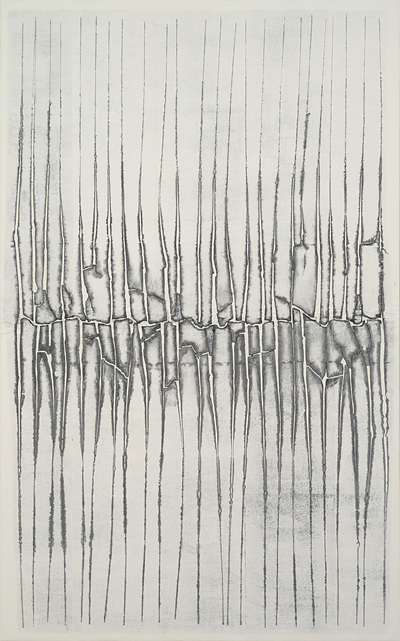News
May 2021
Dansaekhwa Works by Kwon Young-Woo, Park Seo-Bo, and Ha Chong-Hyun Join the Centre Pompidou Permanent Collection
Website: https://www.centrepompidou.fr/en/collections/visual-arts
Kon Young-Woo, Untitled, 1984, gouache, Chinese ink on Korean paper, 259 x 162 cm. Courtesy of the artist’s estate and Kukje Gallery Artist: 박서보 (Park Seo-Bo), 권영우 (Kwon Young-Woo), 하종현 (Ha Chong-Hyun) Website: https://www.centrepompidou.fr/en/collections/visual-arts The Centre Pompidou in Paris recently announced that it will add works by three of Korea’s most celebrated modern artists, Park Seo-Bo, Kwon Young-Woo, and Ha Chong-Hyun, to its permanent collection. The Centre Pompidou, widely recognized as one of the three largest museums in France along with the Louvre and the Musée d'Orsay, houses one of the world’s most celebrated modern and contemporary art collection of approximately 120,000 works, encompassing visual art, photography, new media, film, and design. Considered the largest in Europe, the museum’s collection comes second only to that owned by the Museum of Modern Art (MoMA) in New York. The four works that will become part of the Centre Pompidou’s permanent collection include: two colored hanji works by Kwon Young-Woo; one work from Park Seo-Bo’s color Écriture series; and one work from Ha Chong-Hyun’s signature Conjunction series. All three artists celebrated as masters of Dansaekhwa—the seminal art movement that emerged in postwar Korea and showcased a unique form of Korean modernism—the addition of these works to the Centre Pompidou’s permanent collection not only reinforces the representation of Korean art within the global art scene, but also provides an important point of departure for extensive art-historical discourse surrounding the movement. Kwon Young-Woo's two signature colored hanji works from the 1980s, Untitled (1984) and Untitled (1986), feature surfaces repeatedly punctured with numerous holes, that are then saturated with ink that fills in the spaces in distinctive patterns. Painted with both Western (gouache) and Eastern (Chinese ink) mediums, these works showcase the artistry with which Kwon allowed color to permeate into the paper’s torn edges. These paintings provide a backdrop for the unpredictable encounter between the paper and ink, thereby effectively highlighting the materiality of hanji. Distinguished by its simple yet dynamic aesthetic, Park Seo-Bo's Écriture (描法) No. 120103 (2012) belongs to the artist's late Écriture series which reflects a uniquely Korean spirituality. The series, often also referred to as “color Écriture” due to its vibrant palette, gives insight to Park’s technical approach and philosophy of becoming unified with nature, thus emptying the mind and achieving a higher level of awareness. Ha Chong-Hyun’s Conjunction 85-022 (1985) demonstrates Ha’s exploration of his internationally celebrated technique of bae-ap-bup, a singular method of pushing paint from the back to the front of the burlap canvas. Thick layers of paint that seep through the front are liberally transformed by the artist using a wide range of tools such as knives, brushes, and wooden spatulas, which Ha appropriately modifies in order to create patterns that accentuate the pictorial plane; achieved through this process is the “conjunction” between material and performance. Dansaekhwa has become synonymous with a generation of artists who experienced first-hand the social and political upheaval in 1970s Korea, and who fought for a more liberal approach to visual art practice. Specifically, these artists expanded studio practice to incorporate the language of performance on various two-dimensional surfaces, adopting innovative and often unorthodox technical methods as well as a meditative philosophical perspective. Since its establishment, Kukje Gallery has supported important Dansaekhwa artists including Kwon Young-Woo, Park Seo-Bo, Ha Chong-Hyun, and Lee Ufan. As a part of the “Collateral Events” at the Venice Biennale in 2015, the gallery mounted an unprecedented exhibition of Dansaekhwa artists, celebrating these important figures and providing essential context to recognize their historical contributions. The following year, the gallery launched another special exhibition in collaboration with the Boghossian Foundation in Brussels, titled When Process Becomes Form: Dansaekhwa and Korean Abstraction. In 2018, Shanghai’s Powerlong Museum opened Korean Abstract Art: Kim Whanki and Dansaekhwa, the first-ever comprehensive exhibition of Korean abstract art to be held in China, which established a platform for continued dialogue on the aesthetic impact and ongoing importance of Dansaekhwa internationally.
파리 퐁피두 센터, 권영우, 박서보, 하종현 작가 단색화 작품 영구 소장 파리 퐁피두 센터(Centre Pompidou)가 한국 화단을 대표하는 세 작가 권영우, 박서보, 하종현의 작품을 영구 소장한다고 밝혔다. 루브르 박물관, 오르세 미술관과 함께 프랑스 3대 미술관으로 손꼽히는 퐁피두 센터의 근현대미술 컬렉션은 시각 예술, 사진, 뉴미디어, 영화, 디자인 등 다양한 장르를 아울러 12만여 점에 이르며, 이는 유럽 내 최대이자 뉴욕 현대미술관에 이은 세계 두 번째 규모다. 퐁피두 센터는 권영우의 채색 한지 회화 2점, 박서보의 색채묘법 1점, 하종현의 접합 1점 등 총 4점을 소장한다. 세 작가는 한국 현대미술의 대표적인 흐름이자 성과로 평가받는 단색화(Dansaekhwa)를 대표하는 거장들이다. 퐁피두 센터의 단색화 작품 소장은 국제무대에서 한국미술의 위상을 보여줌과 동시에 해외 미술사적 맥락 속에서 단색화의 학문적 가치에 대한 심도 있는 고찰이 더욱 활발해질 것이라는 기대를 낳고 있다. 권영우(1926-2013)의 채색 한지 회화 2점



